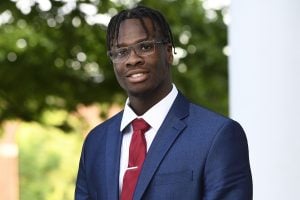
Omobolade Odedoyin ’23 is a part-time data research lead at Pink AI and a student in the Master of Science in Engineering in Data Science program. His interests, sparked by exposure to predictive analytics and mathematical modeling as an undergraduate, now lie at the intersection of mathematics, optimization, statistics, and machine learning. In this Q&A, Odedoyin discusses how his undergraduate years at Hopkins led him to his current job and to pursue a master’s in data science.
You started college interested in neuroscience. Explain your pivot to applied math.
Applied mathematics and statistics was not on my radar when I started out. But while I was doing an undergraduate research assistantship under the guidance of Dr. Amanda Lauer at Johns Hopkins School of Medicine, that changed. I was studying synaptic plasticity in the olivocochlear systems of mice and that involved meticulously analyzing over a thousand confocal microscopy images with thresholding algorithms: wet lab techniques came together with data analytics in this role. This not only culminated in me making contributions to several journal articles but also crystallized my love for extracting patterns and insights from complex data sets. In other words, I recognized the transformative power of data analytics.
As my fascination for numbers and patterns deepened, so did my resolve to pivot from neuroscience to applied mathematics and statistics. This shift was not merely academic; it was a philosophical realignment towards the language of mathematics—the very essence of all real-world quantitative challenges.
In the end, my bachelor’s degree in applied mathematics and statistics provided me with a much-needed foundational background in mathematics: the core language of all real-world quantitative problems.
Which professors served as key motivators and influencers during your undergraduate years.
As I developed a passion for mathematics and its real-world applications, mentors and curiosity about data patterns led me to this field of study. The influence of my professors, particularly Professor Donniell Fishkind (whose courses on Optimization and Mathematical Modeling were instrumental), opened my eyes to the power and underlying mathematical principles of predictive analytics that now underpin my approach to complex data-driven problems. His encouragement and expertise helped shape my research philosophy and work ethic and have inspired my academic growth.
With the guidance of my mentors and the robust quantitative foundation I got at Johns Hopkins, I have developed a proficiency in decision trees, neural networks, and regression algorithms and an appreciation for the nuanced yet powerful concepts of Bayesian and Frequentist statistics. This shift from the structured environment of the Lauer Lab to the exploratory autonomy of my internships, including a transformative stint at the Cohort-Based Integrated Research Community for Undergraduate Innovation and Trailblazing (CIRCUIT) at JHU’s Applied Physics Laboratory, gave me a multifaceted skill set.
Did your Hopkins undergraduate research projects impact your career choice?
I worked on a project titled “Predictive Modeling for Centrifugal Contactor Solvent Extraction” which significantly shaped my career trajectory. This research was aimed at developing a predictive model for color outcomes in centrifugal contactor solvent extraction processes, crucial for nuclear non-proliferation efforts. (Centrifugal contactors are used in the nuclear industry to separate and purify materials involved in nuclear fuel cycles—and certain colors indicate the presence of certain materials in the liquid. These color signatures can help detect unwanted diversion of nuclear materials.)
Challenges arose due to missing sensor data, impacting the model’s accuracy. To address this, we used a dual-path strategy, assessing datasets with and without complete sensor readings. Despite missing data, we found that we could still construct robust models, highlighting for me the adaptability of machine-learning approaches and creative problem-solving in data science.
This project gave me a vital skill of navigating complex data landscapes—one that I have carried forward into my role at Pink AI. It fortified my data analytics and problem-solving skills, essential for the quantitative research roles I want to pursue.
Describe your role at Pink AI.
Pinkai.io, known as Pink AI, is a health care technology company that offers a modern AI-driven approach to mental health counseling. It is designed to be affordable, accessible, private, and personalized, making mental health support significantly cheaper and available anytime. The platform ensures complete confidentiality with no data sharing, allowing users to customize the AI to their preferences. Pink AI supports personal development with guidance from experts and mentors, aiming to improve lives globally by also providing complimentary access to those in need. As data research lead, I lead the data collection efforts for the development of AI chatbot.
We aim to create an AI bot offering mental health care guidance, drawing insights from diverse sources. It is important that we ensure the resulting advice is both accurate and ethically sound. We are currently exploring the possibilities of creating a separate app or leveraging the OpenAI GPT store for community integration, showcasing our commitment to responsible AI development. I am grateful for this opportunity as it has positioned me to harness the power of machine learning and AI for novel pathways in medicine and health care.
What advice would you offer to students aspiring to pursue a career in your field?
My advice is to embrace both the structured and uncertain aspects of research. Stay curious, be adaptable, and cultivate a multidisciplinary approach to problem-solving. And don’t forget the value of patience and perseverance through challenging projects. My pivot to AMS was very lengthy but irreplaceable, as it tested and strengthened my faith in Jesus Christ and my connections to my family and friends and provided me with a comprehensive opportunity to tailor my course load to my academic pursuits. Ask yourself if you really like whatever you are doing and make sure that the answer is a resounding “Yes” before you continue. Please don’t shy away from challenges, and taste everything so when you find your favorite flavor of study, you know it’s because it is better suited for you than all the others.